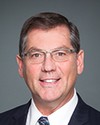There are no planes. Between the 42 stops between Winnipeg and Churchill, there are no planes. That is why the Government of Canada provides a service. It is the same thing on the Canadian from Toronto to Vancouver. On the over 200 stops on that line, there are no planes. At some of those stops, there are no roads. That is why the Government of Canada provides rail service. But that is not my preoccupation. It's my duty to do that as long as the government asks me to do it.
My preoccupation is the Quebec-Windsor impression being given that the traffic growth would come from planes. As I was trying to demonstrate.... What I just said applies there too. If you're in Drummondville, Cobourg, Belleville, or Aldershot, you do not have a plane alternative.
The high-frequency train project we have demonstrates that it will eliminate five million car trips. How many car trips are there between Montreal, Ottawa, and Toronto per year? Thirty-eight million, and they have no substitution, because there is no plane, obviously.
That's where that traffic is coming from. There will be some coming from planes, but on the total corridor there are 45 million trips: 8% by plane, 6% by train, and the rest on the road. This is where we have to come up with an alternative to get people out of those cars, killing our children and our future with carbon gas emissions.... It's by putting them on trains, where they can be not only safer and faster in getting into the cities, but more productive while they're doing it. That's the approach here. I make that correction.





